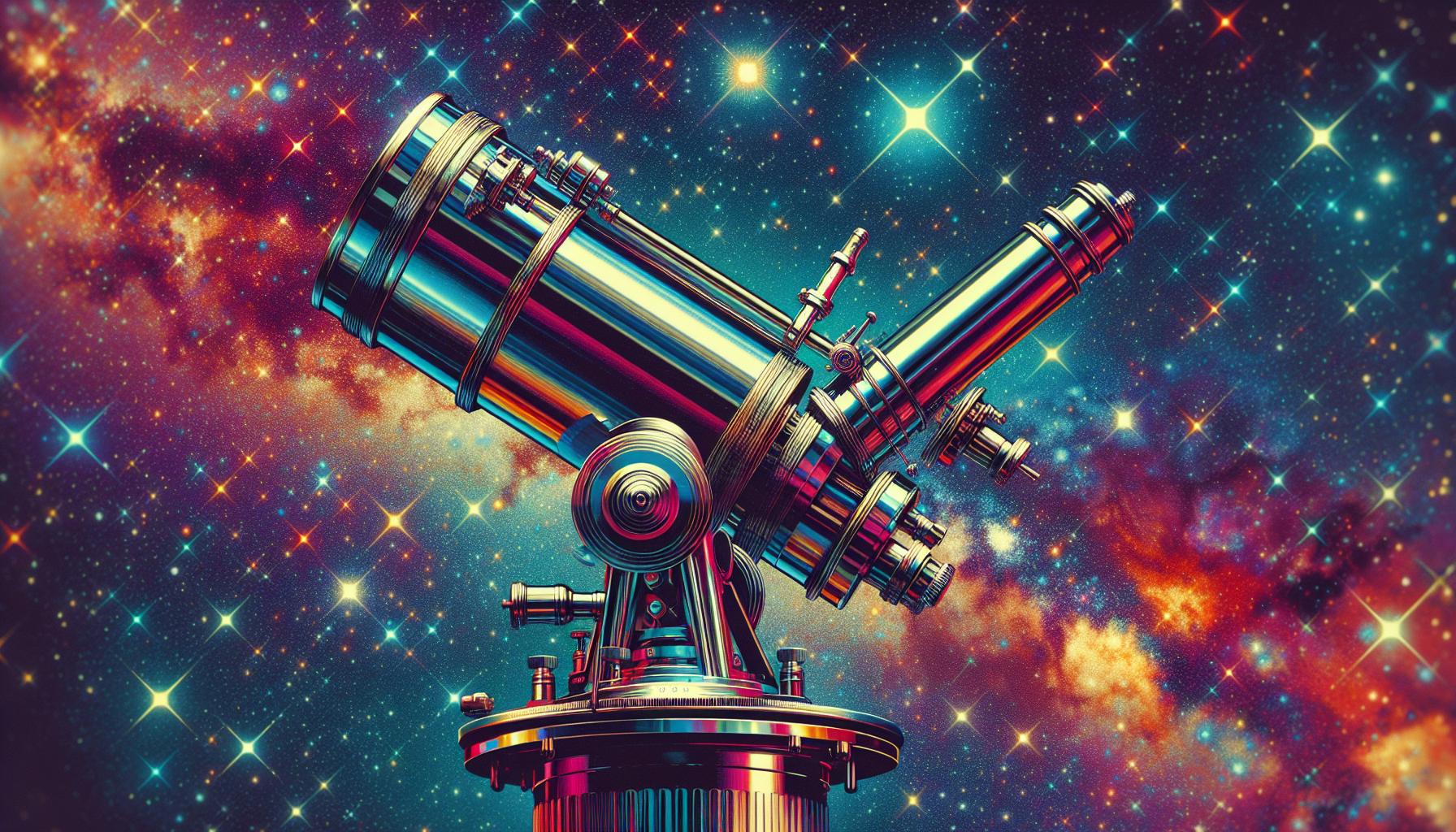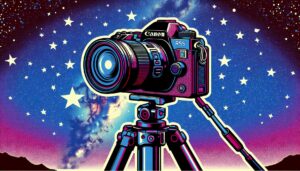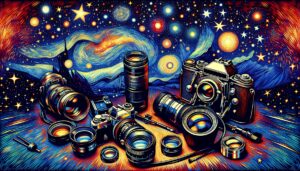This site contains affiliate links to products. I may receive a commission for purchases made through these links.
I’ve spent countless hours under the stars, camera in hand, capturing the beauty of the cosmos. If you’re like me, you know that astrophotography isn’t just about the camera. It’s the telescope that makes all the difference.
Choosing the right telescope can be daunting. There’s a myriad of factors to consider – aperture, focal length, mount type, to name a few. But don’t worry, I’ve got your back.
In this article, I’ll guide you through the best types of telescopes for astrophotography. Whether you’re a seasoned stargazer or a budding astronomer, you’ll find the perfect telescope to capture those awe-inspiring celestial bodies. Let’s dive in.
Factors to consider when choosing a telescope for astrophotography
While you’ve learned that the choice of telescope is crucial in astrophotography, you’re probably wondering, “What exactly should I consider when selecting one?” The key factors in making an informed decision are aperture, focal length, and mount type.
Aperture is the most critical aspect to consider. It’s the diameter of the telescope’s lens or mirror, and a larger aperture allows more light in. With this additional light, you’re able to see fainter objects and get better details of celestial bodies. It’s beneficial to go for the larger aperture if the environment and budget allow for it.
With focal length, it’s all about the field of view and image scale. A longer focal length means a narrower field of view but larger image scale, allowing you to capture small and distant celestial objects. A shorter one, on the other hand, offers a wider field of view perfect for capturing large nebulas and clusters.
| Aspect | Short Focal Length | Long Focal Length |
|---|---|---|
| Field of View | Wide | Narrow |
| Image Scale | Small | Large |
| Best for | Large Nebulas and Clusters | Small, Distant Celestial Objects |
The mount type is the last but not the least important factor. A robust mount is essential to eliminate vibrations and movements. There are two main types of mounts: alt-azimuth and equatorial. Alt-azimuth is simpler to use and great for viewing. However, for long-exposure astrophotography, an equatorial mount is the gold standard as it can track objects as they move across the sky, keeping them in the frame.
Each factor has its significance, and knowing what you want to photograph will help determine the best telescope for your needs.
Refractor telescopes
Let’s delve deeper into one specific type of telescope gaining popularity among astrophotographers: Refractor Telescopes. These instruments have a special place in the astrophotography realm, and there are a few reasons for this growing interest.
First and foremost, Refractor telescopes, also known as a refracting telescope, use a set of lenses to gather and focus light. They are specifically designed to deliver sharp, high-contrast images. This makes them particularly effective for capturing details in high-resolution astrophotography.
One distinct advantage of a refractor over other types of telescopes is their closed tube design. It protects the interior lens elements, keeping them clear of dust and debris. Hence, refractors often prove more durable and require less maintenance.
Another significant selling point for refractors is their lack of color distortion, also called chromatic aberration. The nature of their design minimizes this issue. That results in clear, untainted images, crucial for capturing those far away cosmic bodies in all their beauty.
A common misconception about astrophotography is that bigger is always better, which is why some people rush out to buy the telescope with the largest aperture they can afford. With refractor telescopes, it’s not always about the size of the aperture but about the quality of the lens system. Quality often trumps quantity in astrophotography.
Given their benefits, refractors are an excellent option for astrophotographers. They combine performance, longevity, and image clarity. However, it’s important to note that they can be pricier than other types of telescopes. Yet the satisfaction from capturing brilliant, crisp images of celestial bodies can be worth the investment.
The choice of a refractor telescope becomes even more valuable when we recall that in astrophotography, every detail counts. Looking ahead, we’ll dive into other types of telescopes and dig out pros and cons for each one. We’ll also touch upon how to make a well-informed decision based on what you aim to capture, your budget, and your experience level.
Reflecting telescopes
Transitioning from refracting telescopes, let’s dip our toes into the world of reflecting telescopes. Reflectors operate on a fundamentally different principle: they use mirrors to gather and focus light. Mirrors allow for a larger aperture at a lower cost, which means you’ll be capturing more light and consequently, more detailed deep-sky images. That’s exactly what we need for astrophotography!
Reflecting scopes aren’t just about large apertures. They’ve got their own list of advantages. Less color distortion, also known as chromatic aberration, is one of them. Since reflectors use mirrors instead of lenses, they do not create rainbow halos around bright objects – a problem often found in refractors. Their open tube design, as opposed to the closed tube of a refractor, allows for some degree of self-cleaning; dust and other tiny particles that may interfere with the imaging process are less likely to accumulate.
But let’s not gloss over the drawbacks. The same open tube design that aids self-cleaning can also leave the interior exposed to the elements, requiring more frequent cleaning and calibration to maintain optimal performance. The mirror system can also introduce a phenomenon called coma – a distortion that makes stars appear comet-like at the edges of the field of view.
Nevertheless, given their relatively low cost and wide aperture, reflecting telescopes can be an attractive choice for many astrophotographers. Particularly for those who are just starting out or on a budget.
So, reflecting or refracting? It’s not a question with a one-size-fits-all answer. You have to take into account what you’re looking to capture, your available budget, and the level of maintenance you’re prepared to undertake. It all boils down to what you require and what you can work with.
Next, we delve into another category of telescopes – catadioptric telescopes. Stay tuned as we unfold more details about these all-rounders in the realm of astrophotography.
Catadioptric telescopes
Moving forward, let’s delve into the intriguing world of Catadioptric telescopes. These telescopes utilize a hybrid design, combining lens and mirror optics to form an image. Their main advantage? They offer the best of both worlds – the clarity of refractors and the low color distortion and large apertures of reflectors.
Catadioptric telescopes come in two popular designs: Schmidt-Cassegrain and Maksutov-Cassegrain. Both designs are highly versatile and portable, making them an astrophotographer’s dream.
The Schmidt-Cassegrain design is noted for its versatility and suitability for deep-sky and planetary observatory. However, its field curvature might require additional correcting lenses for astrophotography, increasing the overall cost.
On the other hand, the Maksutov-Cassegrain design, with its sharper and flatter image field, might be a better choice for planetary photography. It’s a bit more expensive upfront, but doesn’t require the same additional lenses for correction, potentially saving money in the long run.
It’s not all sunshine and rainbows with catadioptric telescopes, though. They may demand more maintenance compared to reflectors and refractors, owing to their complex optical systems. Additionally, their typically slow focal ratios may prove challenging when capturing deep-sky objects.
Ultimately, the best telescope for you depends on what you aim to photograph, your budget, and how dedicated you are in terms of maintenance. Catadioptric telescopes, with their hybrid features and flexibility, might just be the perfect fit for some astrophotographers.
As we continue our journey through the cosmos of astrophotography equipment, we’ll look at auxiliary tools that can enhance your astrophotography experience. From mounts and trackers to filters and imaging software, these tools are crucial for capturing stunning images of the night sky. Stay tuned.
Comparing the three types of telescopes for astrophotography
When it comes to astrophotography, the key aspect to consider in a telescope is its optical design. Refractors, Reflectors, and Catadioptric telescopes each have unique qualities that make them well suited for different types of astrophotography.
Let’s start with Refractors. These telescopes have a reputation for crisp, clear images and require little maintenance. Although they might be seen as top-tier for planetary and lunar photography, they sometimes fall short for deep-sky photography. This is mainly because of their smaller apertures compared to other types.
On the other hand, Reflectors offer larger apertures at a reasonable cost. This makes them exceptional for capturing deep-sky objects like galaxies and nebulae. They do, however, require more frequent collimation (alignment of optics) and may suffer from coma, an optical aberration resulting in distorted images at the edge of the field of view.
Moving onto the Catadioptric telescopes, their main advantage lies in their versatility. They bring together the strengths of both refractors and reflectors. This allows you to take great shots of various celestial bodies without having to switch telescopes. But, their slower focal ratios may render them less effective for certain types of deep-sky photography.
To help you visualize, here’s a table comparing some of these attributes:
| Telescope Type | Optical Quality | Maintenance | Astrophotography |
|---|---|---|---|
| Refractor | High | Low | Good for planets and moon |
| Reflector | High (with potential for coma) | Higher (requires more collimation) | Good for deep-sky objects |
| Catadioptric | Versatile | Moderate (more than refractors but lesser than reflectors) | Versatile (good for various celestial bodies) |
It’s important to remember though, that the best type of telescope for you heavily relies on what you hope to accomplish with your stargazing adventures. Understanding your own interests and resources is pivotal in making the right decision.
Mount types for astrophotography telescopes
After we’ve looked at the features of refractor, reflector, and catadioptric telescopes, it’s time to discuss a key factor that influences image quality just as much – the mount type. Without a solid, reliable mount, even the best telescope won’t do you much good.
There are mainly two types of telescope mounts that work well for astrophotography: Altazimuth (Alt-Az) mounts and Equatorial (EQ) mounts. Let’s dive into the specifics of each.
Alt-Az mounts are easy to operate. Moving up and down (altitude) and left to right (azimuth), they provide an intuitive way to navigate the night sky. Despite their simplicity, they do have one major drawback for astrophotography – field rotation. This means the Alt-Az mount does not move with the earth’s rotation, so over time, the stars will appear to rotate in the field of view.
On the flip side, EQ mounts are designed to follow the rotation of the earth, which eliminates field-rotation problem. They may be more challenging to get the hang of, but are generally more suited to astrophotography. With an EQ mount, you can take long-exposure images without worrying about star trails — a common problem when using an Alt-Az mount for astrophotography.
Choosing between these two mounts depends on your goals. If you’re in it for low-exposure lunar or planetary photography, an Alt-Az could be a cost-effective option. However, if deep-sky objects and long-exposure photography are what you’re after, an EQ mount is highly recommended.
Either way, remember it’s more than just the telescope that counts in astrophotography. The right mount for your telescope and type of photography can make or break your stargazing experience. With the suitable mount attached, you’ll be confidently — and efficiently — roaming the night sky.
Conclusion
Choosing the right telescope for astrophotography isn’t just about the lens or the aperture. It’s about the mount too. Alt-Az mounts are user-friendly but they do have their limitations. On the other hand, EQ mounts align with the Earth’s rotation, making them the go-to choice for serious astrophotographers. Your goals and the kind of shots you want to capture will determine which mount’s right for you. Remember, successful astrophotography starts with the right equipment. So make your choice wisely.
What are the two main types of mounts for astrophotography?
There are two primary mount types for astrophotography: Altazimuth (Alt-Az) mounts and Equatorial (EQ) mounts. These differ in structure, ease of use, and suitability for astrophotography.
What is an Altazimuth (Alt-Az) mount?
An Alt-Az mount is straightforward to operate and ideal for casual sky-watching. However, it has a drawback known as field rotation which can affect long-exposure astrophotography.
What is Equatorial (EQ) mount and why is it suitable for astrophotography?
Equatorial mounts are designed to follow the rotation of the earth. They are excellent for long-exposure astrophotography because they effectively track sky objects and reduce image distortion.
How do I choose the right mount for astrophotography?
Selecting the right mount depends on your astrophotography goals. For casual sky-watching, an Alt-Az mount is sufficient. For extended exposure shots and detailed astro-imaging, the EQ mount is the best choice.
Why is choosing the right mount important in astrophotography?
The right mount can greatly affect the quality of astro-images. It determines how well a telescope tracks celestial objects, which is crucial for achieving clear and accurate photographs of the night sky.




